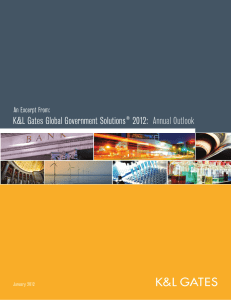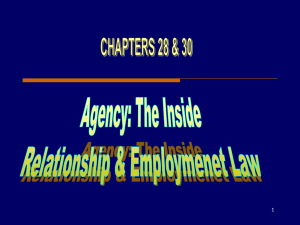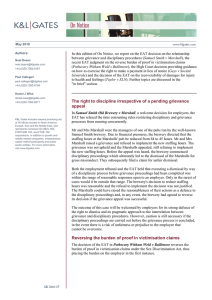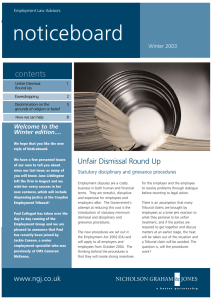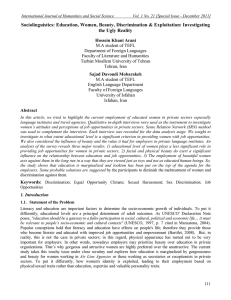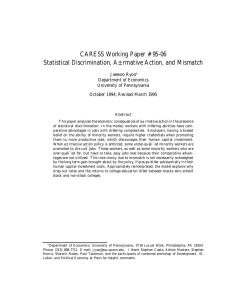people resourcing
advertisement
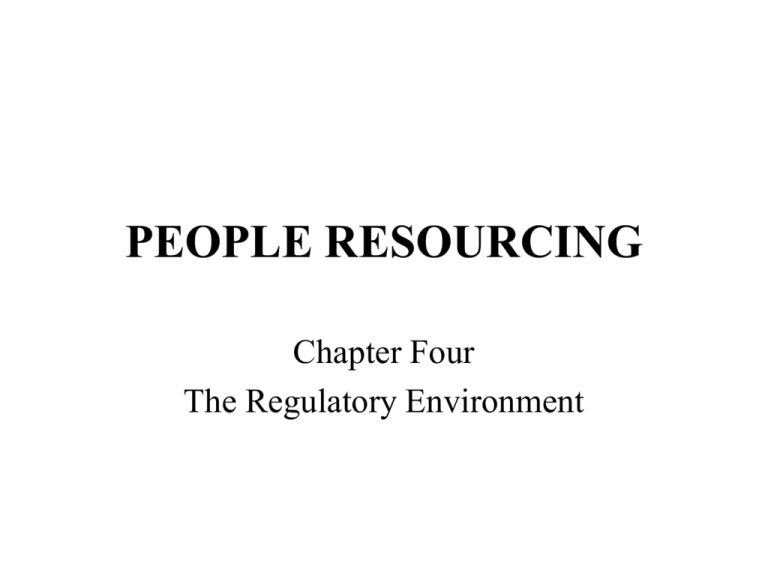
PEOPLE RESOURCING Chapter Four The Regulatory Environment One of the most significant current developments in the P&D business environment is the growing volume of regulation that governs the employment relationship in the UK. Until the 1960s, employers were able to manage their organisations to a large extent without the limitations that are now imposed through statute. Where employee interests were represented, this was because of trade union membership. Over the past 40 years, the situation has changed to a considerable extent. 1965 1970s 1980s 1995 1998 - Statutory redundancy payments Fledgling industrial tribunal service Unfair dismissal law Equal pay legislation Freedom from sex/racial discrimination Extended health and safety regulations TUPE Regulatory regime for trade unions Disability discrimination law National minimum wage Working time regulations Data protection law Since 2000 - Protection for part-time workers and agency staff; freedom from discrimination on the grounds of sexual orientation, religion and age; extended family rights; etc. Employment regulation has increased substantially, but in a piecemeal, step-by-step fashion. Contributing factors: • UK membership of the EEC and now the EU • decline in trade union membership and activism • government economic policy – desire to encourage people to ‘come off the welfare state and into work’ • just another area of national life that has become more regulated • political expediency. Discrimination law Basic aims: 1. to ensure that employers treat people equally 2. to protect groups who are vulnerable to discrimination from less favourable treatment on the part of employers. Anti-discrimination laws in the UK cover detrimental treatment on a variety of different grounds. The individual measures work in different ways: • Some cover all ‘workers’ whereas others cover only ‘employees’. • Some give a wide degree of protection whereas others permit employers flexibility where it can be ‘objectively justified’. Dismissal law Three types of claim: 1. Unfair dismissal – breach of statute (the most common) 2. Wrongful dismissal – breach of contract 3. Constructive dismissal – employee resigns as a direct result of unreasonable employer conduct. 2004 Measures introduced to reduce the number of tribunal cases by encouraging dismissed employees to make use of employers’ mandatory appeal mechanisms 2006 Gibbon Report concluded that these procedures had not met their objectives. Law of contract Part of the common law, thus largely judge-made: • A contract of employment is only established when a clear, unambiguous and unconditional offer has been made and accepted. • Contracts cannot be changed unilaterally by one party. • Once established, a contract confers duties on both parties. In practice, this means: • An offer letter must be issued, accompanied by a summary of the key terms and conditions of employment. • Employers should explicitly build a degree of flexibility into any contracts that they offer. • All individuals undertaking a supervisory role must have basic training on the law of contract – including the issue of implied terms. Family-friendly statutes Range of new rights designed to make it easier for people with family responsibilities to combine these with a career. Includes rights to maternity leave, maternity pay, paternity leave, parental leave, time off to care for dependants and requesting flexible working. P&D professionals must administer such matters professionally, and to build assumptions about the take up of these rights into their human resource planning activities. Working Time Regulations Complex legislation that has been heavily criticised for lacking clarity. Central to human resource planning and the organisation of work. Confidentiality issues • Public Interest Disclosure Act 1998 (whistle-blowing) • Telecommunications (Lawful Business Practice) (Interception of Communications) Regulations 2000 • Data Protection Act 1998 Debates about employment regulation Two types of debate: • micro-debates: effectiveness of particular pieces of legislation • macro-debates: the rights and wrongs of regulating the labour market through employment protection legislation. Micro-debates Individual pieces of legislation – do they ‘go too far’ (employer organisations) or ‘not go far enough’ (employee perspective)? Some areas of employment regulation are generally agreed by all parties to function badly: • Some laws fail to meet their own objectives – being burdensome for employees, yet ineffective for staff (equal pay law) • Badly drafted law, leaving substantial uncertainty • Unnecessary complexity. Macro-debates Is increased employment regulation beneficial or harmful to the UK’s economy and people? Two views: 1. Anti-regulation (CBI, IOD, etc): - Regulation serves to place substantial additional costs on employers, which has the effect of making UK businesses less competitive in international markets. - The long-term effect is the need for employers to shed labour and create unemployment. - Regulations impose a single, standard way of doing things, which means that local flexibility is reduced. 2. Pro-regulation: - Employment law is necessary to protect vulnerable people who might otherwise be unjustly exploited. - With current tight labour markets, it is in our economic interests for the government to force employers to provide workplaces in which people want to work, and terms and conditions that attract them into employment. - Fair, equitable treatment will result in increased employee loyalty and productivity.




